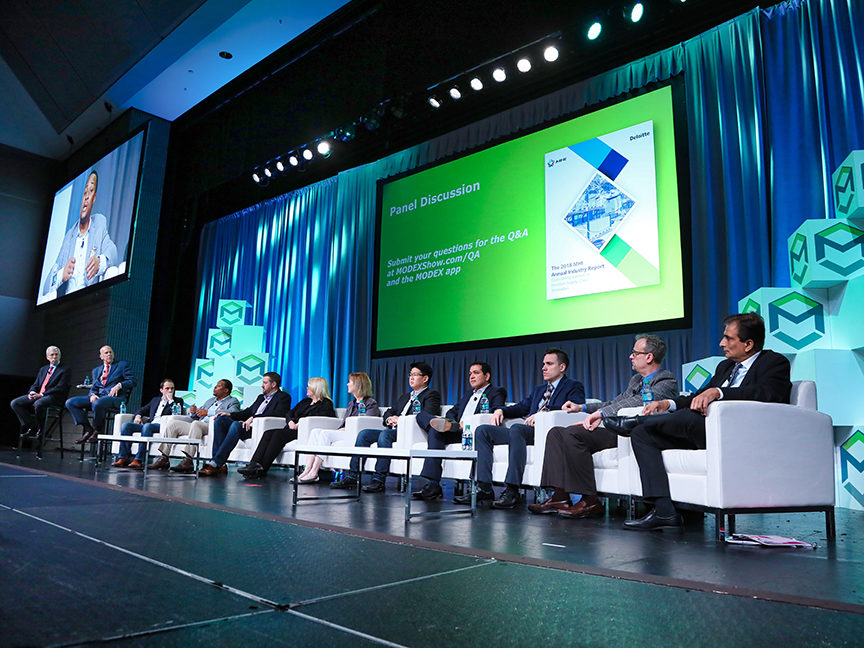
Visit Our Sponsors |
|
|
|
|
|
|
|
|
|
|
|
|
|
|
|
|
|
|
|
|
|
|
|
|
|
|
|
|
|
|
|
|
|
|
|
|
|
|

Editor's note: This article has been updated to reflect highlights from the show.
Wednesday highlights: Inventory visibility, digitization
Visibility remains the biggest challenge when coping with supply chain disruptions. “The supply chain changed rapidly through the pandemic, and we recognized the main problem was the visibility of where inventory was,” said Bill Denbigh, vice president of product marketing at Tecsys. “There was never a PPE shortage. There was a PPE visibility problem.”
The key to high-detail inventory visibility is supply chain digitization, said Tom Jensen, head of system solutions at Murrelektronik. “Everyone’s supply chain right now is really messed up. The solution is a digital twin.”
"There was never a PPE shortage. There was a PPE visibility problem.” —Bill Denbigh, @Tecsys_Inc VP of product marketing at #MODEX2022 #supplychainvisibility
— SupplyChainBrain (@SCBrain) March 30, 2022
Siloed solutions
Warehouse automation can be useless without a holistic approach, said Rupesh Narkar, director of sales for Swisslog's logistics automation business segment. These technologies tend to address specific functions, such as order picking or packing, but businesses should “consider the upstream and downstream functions,” he said. “Digitization has to be part of the entire operation.”
Tuesday highlights: Worker woes
The supply chain labor shortage is a hot topic at MODEX 2022, and attendees are being encouraged to embrace automation and robotics — or get savvy about attracting and retaining millennial and Gen Z workers. Younger generations are known for high employee turnover, which is particularly problematic for warehouses, said Kelley Wood, global customer marketing manager for supply chain at Honeywell.
“In a warehouse, it’s tough to have people constantly coming in and out,” she said. “So you either embrace automation and robotics, or get your workers up and running in hours — not days.”
More top themes we’re hearing onsite:
Monday highlights: The future of automation
As the pace of change accelerates in material handling automation, what manual processes might finally be possible to automate, and how can existing solutions be improved? Robots that can load and unload trucks are one such advancement around the corner, said Dean Terrell, senior vice president at Material Handling Systems Inc. (MHS). Other near-term developments to watch include “networked learning” between bots and factories, touch-responsive sensors that can detect friction and texture, and improved collaboration between humans and machines, said Dan Popa, director of the Louisville Automation and Robotics Research Institute.
Four future capabilities of material handling automation, as heard at #MODEX2022:
— SupplyChainBrain (@SCBrain) March 29, 2022
• better human-robot collaboration
• more "networked learning" between bots and factories
• tactile sensors that detect friction and texture
• unmanned machines that load and unload trucks
Meaty micro-fulfillment
There’s a lot to evaluate before implementing a micro-fulfillment solution: order profiles, inventory management demands, SKU velocity, seasonal peaks, turnover rates and more. The criteria vary from retailer to retailer, but fundamentally, they require “striking a balance between the customer’s in-store and e-commerce experience,” said Saif Sabti, vice president of business development and strategy at Schaefer Systems International Inc. “One should not cannibalize the other.”
ATLANTA—Join SupplyChainBrain on Monday, Tuesday and Wednesday at MODEX 2022, an annual supply chain trade show sponsored by material handling association MHI.
The event boasts more than 100 educational sessions with over 900 equipment and technology exhibitors.
Here’s where you can find us:
RELATED CONTENT
RELATED VIDEOS
Timely, incisive articles delivered directly to your inbox.

